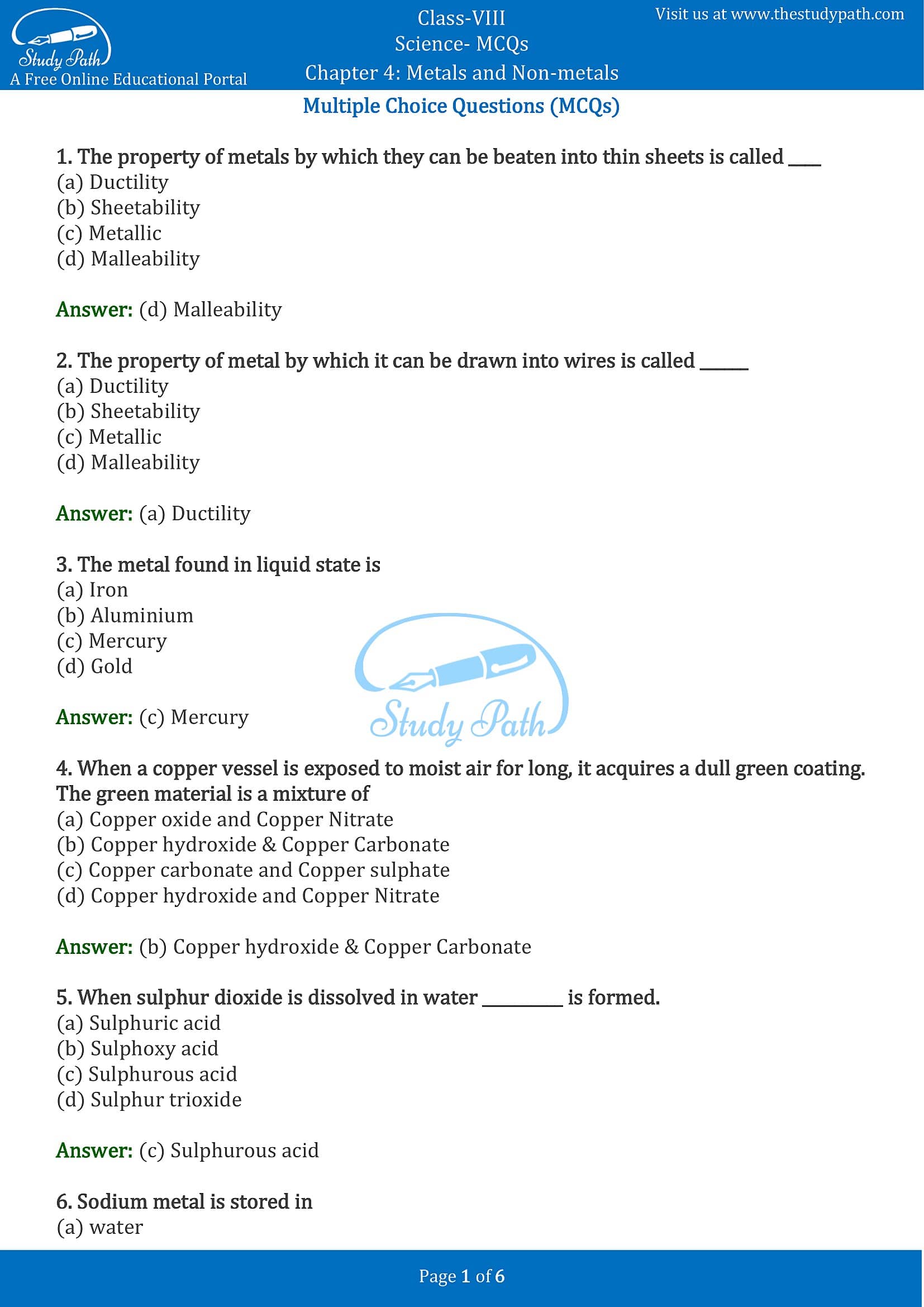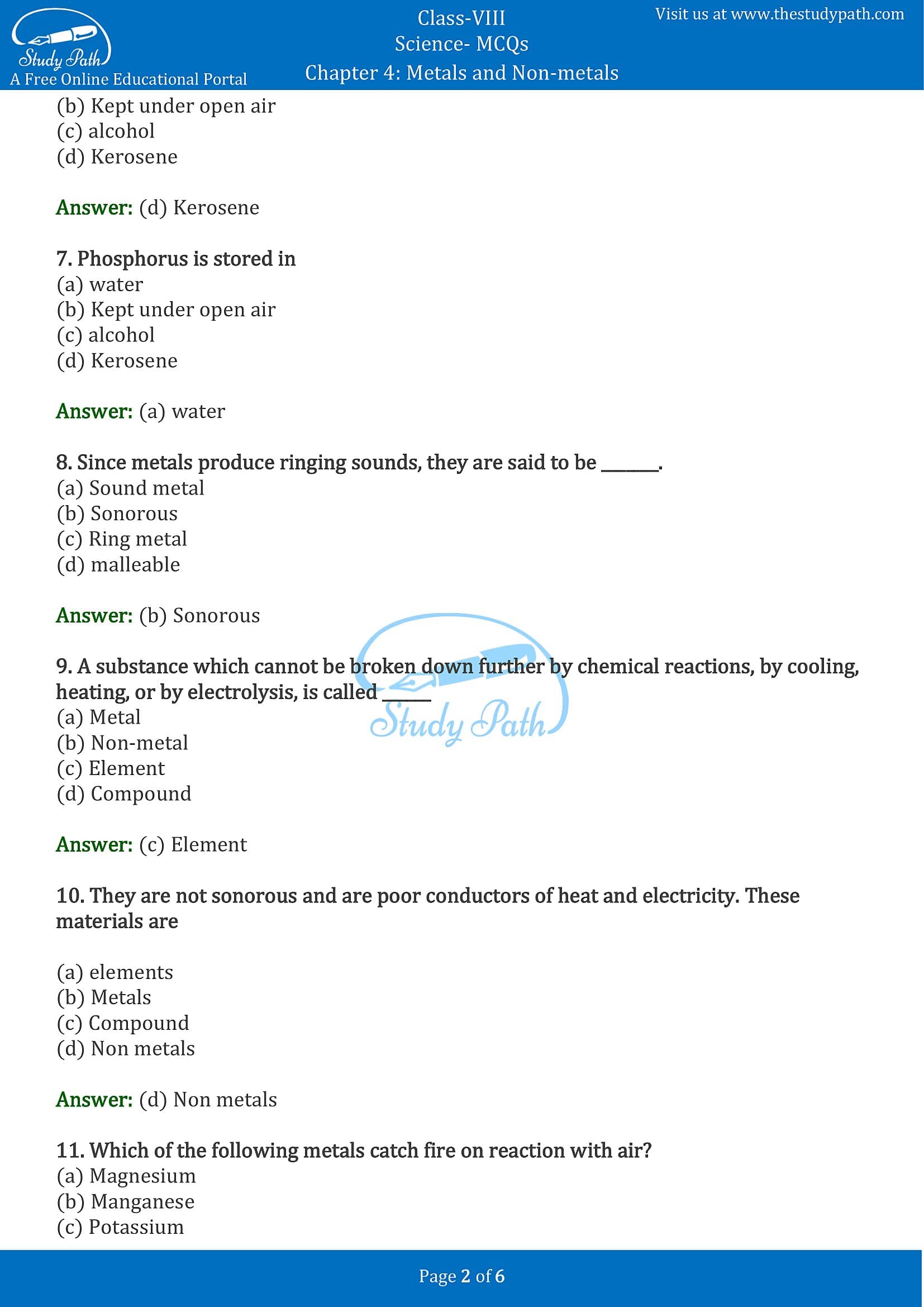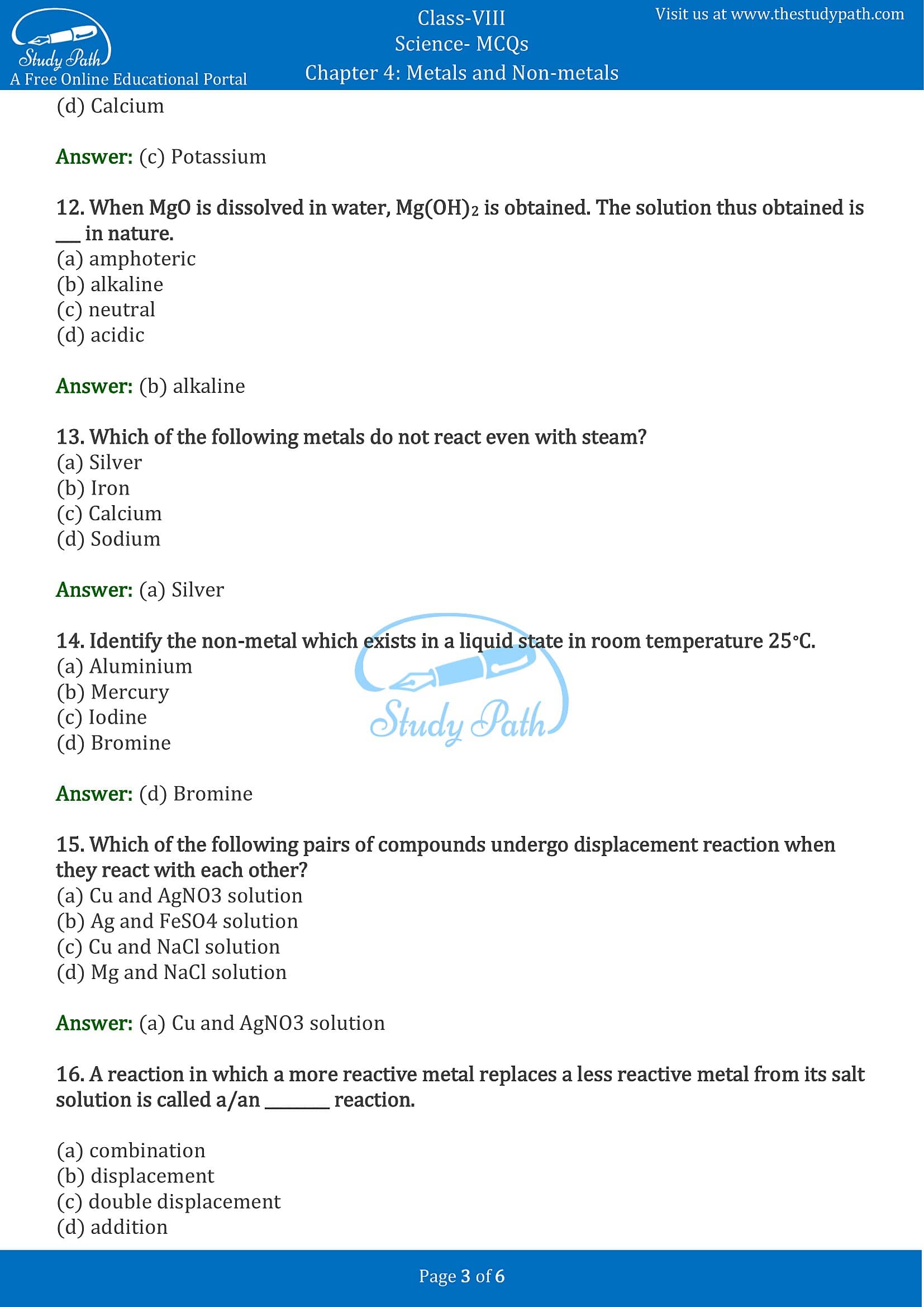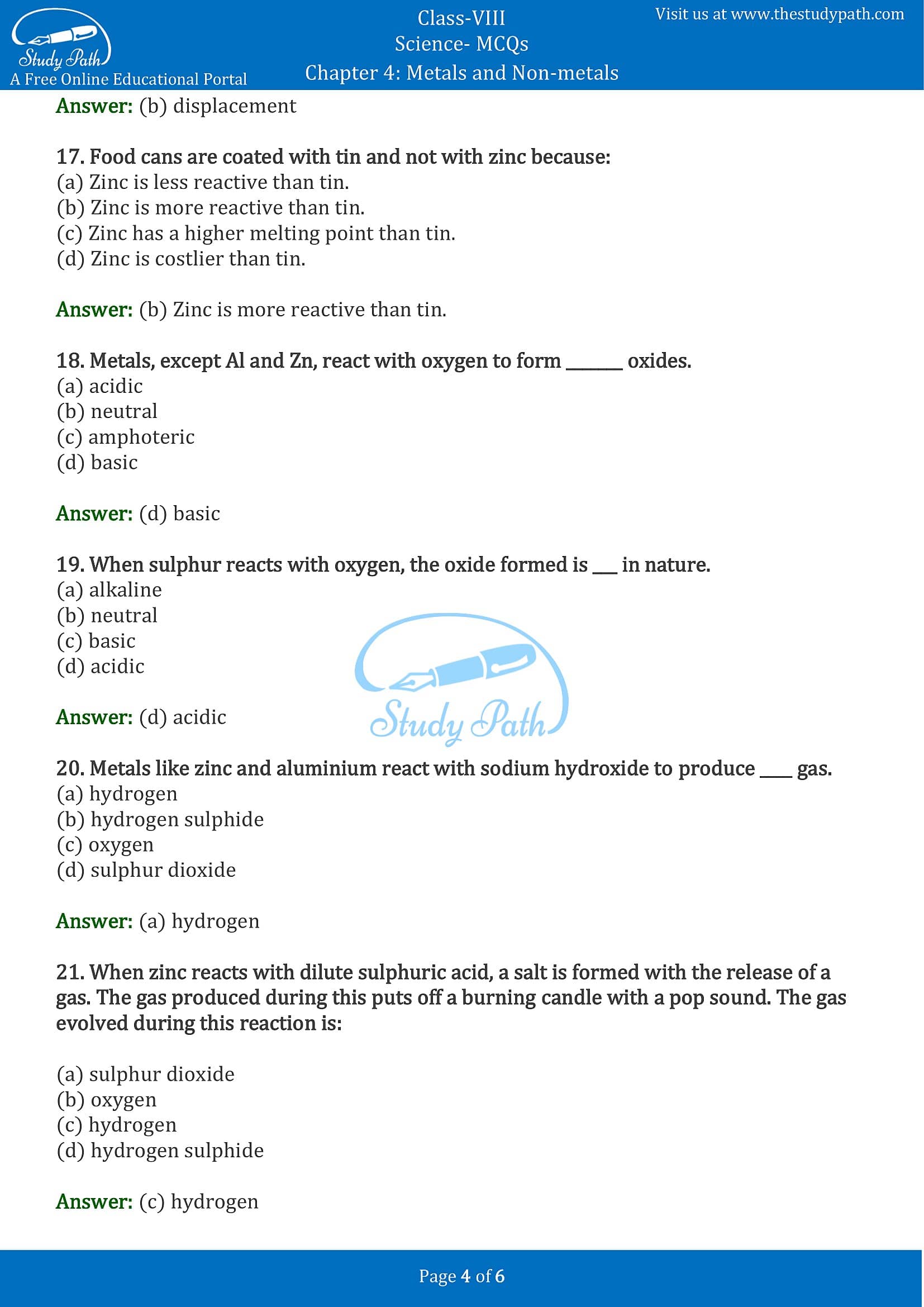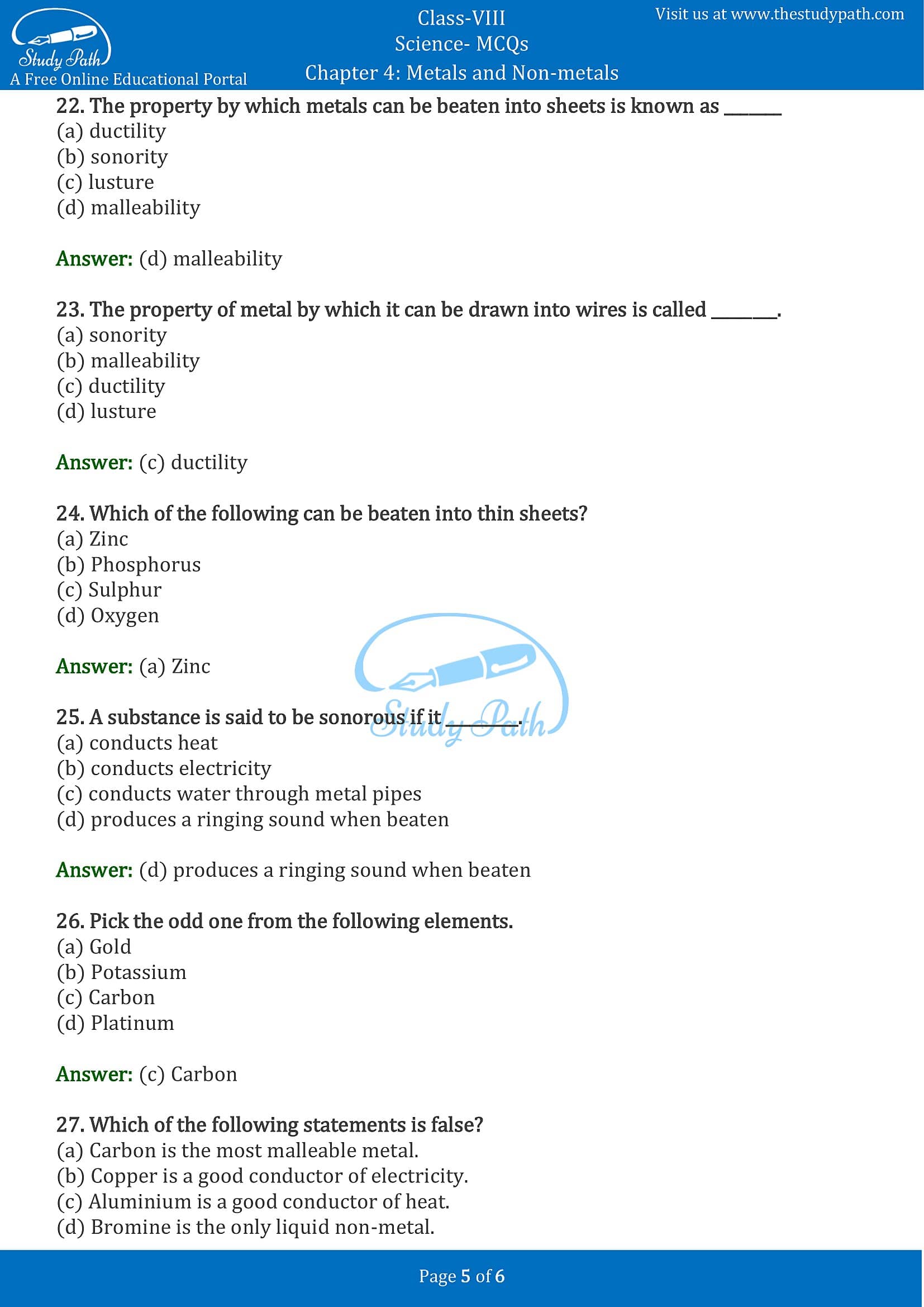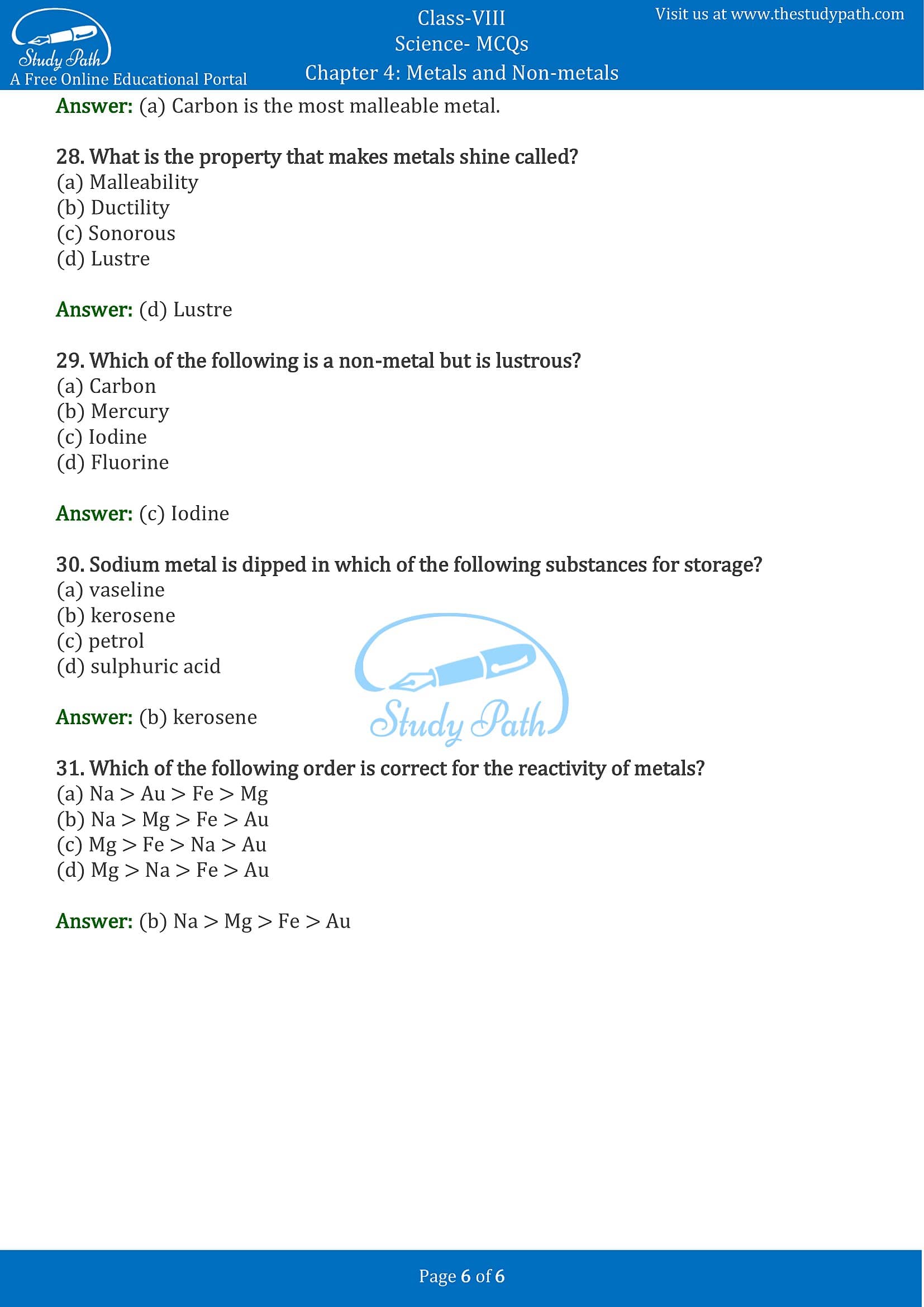Class 8 Science Chapter 4 Materials: Metals and Non-metals MCQ with Answers
Class 8 Science Chapter 4 Materials: Metals and Non-metals MCQ (Multiple Choice Questions) with Answers is available here in PDF format. CBSE Class 8 Science Metals and Non-metals Objective Questions help the students to understand the concepts thoroughly and to score good marks. Practicing these MCQs will help you to answer every question that is being asked in the exams.
At Study Path, you can download PDF of Multiple Choice Questions for Class 8 Chapter 4 Metals and Non-metals for free. We prepared these MCQs on the basis latest exam Pattern. Students can solve NCERT Class 8 Science Metals and Non-metals MCQs before exams to know their preparation level.
Materials: Metals and Non-metals Class 8 MCQ with Answers
Multiple Choice Questions (MCQs)
1. The property of metals by which they can be beaten into thin sheets is called ____
(a) Ductility
(b) Sheetability
(c) Metallic
(d) Malleability
Answer: (d) Malleability
2. The property of metal by which it can be drawn into wires is called ______
(a) Ductility
(b) Sheetability
(c) Metallic
(d) Malleability
Answer: (a) Ductility
3. The metal found in liquid state is
(a) Iron
(b) Aluminium
(c) Mercury
(d) Gold
Answer: (c) Mercury
4. When a copper vessel is exposed to moist air for long, it acquires a dull green coating. The green material is a mixture of
(a) Copper oxide and Copper Nitrate
(b) Copper hydroxide & Copper Carbonate
(c) Copper carbonate and Copper sulphate
(d) Copper hydroxide and Copper Nitrate
Answer: (b) Copper hydroxide & Copper Carbonate
5. When sulphur dioxide is dissolved in water __________ is formed.
(a) Sulphuric acid
(b) Sulphoxy acid
(c) Sulphurous acid
(d) Sulphur trioxide
Answer: (c) Sulphurous acid
6. Sodium metal is stored in
(a) water
(b) Kept under open air
(c) alcohol
(d) Kerosene
Answer: (d) Kerosene
7. Phosphorus is stored in
(a) water
(b) Kept under open air
(c) alcohol
(d) Kerosene
Answer: (a) water
8. Since metals produce ringing sounds, they are said to be _______.
(a) Sound metal
(b) Sonorous
(c) Ring metal
(d) malleable
Answer: (b) Sonorous
9. A substance which cannot be broken down further by chemical reactions, by cooling, heating, or by electrolysis, is called ______
(a) Metal
(b) Non-metal
(c) Element
(d) Compound
Answer: (c) Element
10. They are not sonorous and are poor conductors of heat and electricity. These materials are
(a) elements
(b) Metals
(c) Compound
(d) Non metals
Answer: (d) Non metals
11. Which of the following metals catch fire on reaction with air?
(a) Magnesium
(b) Manganese
(c) Potassium
(d) Calcium
Answer: (c) Potassium
12. When MgO is dissolved in water, Mg(OH)2 is obtained. The solution thus obtained is ___ in nature.
(a) amphoteric
(b) alkaline
(c) neutral
(d) acidic
Answer: (b) alkaline
13. Which of the following metals do not react even with steam?
(a) Silver
(b) Iron
(c) Calcium
(d) Sodium
Answer: (a) Silver
14. Identify the non-metal which exists in a liquid state in room temperature 25∘C.
(a) Aluminium
(b) Mercury
(c) Iodine
(d) Bromine
Answer: (d) Bromine
15. Which of the following pairs of compounds undergo displacement reaction when they react with each other?
(a) Cu and AgNO3 solution
(b) Ag and FeSO4 solution
(c) Cu and NaCl solution
(d) Mg and NaCl solution
Answer: (a) Cu and AgNO3 solution
16. A reaction in which a more reactive metal replaces a less reactive metal from its salt solution is called a/an ________ reaction.
(a) combination
(b) displacement
(c) double displacement
(d) addition
Answer: (b) displacement
17. Food cans are coated with tin and not with zinc because:
(a) Zinc is less reactive than tin.
(b) Zinc is more reactive than tin.
(c) Zinc has a higher melting point than tin.
(d) Zinc is costlier than tin.
Answer: (b) Zinc is more reactive than tin.
18. Metals, except Al and Zn, react with oxygen to form _______ oxides.
(a) acidic
(b) neutral
(c) amphoteric
(d) basic
Answer: (d) basic
19. When sulphur reacts with oxygen, the oxide formed is ___ in nature.
(a) alkaline
(b) neutral
(c) basic
(d) acidic
Answer: (d) acidic
20. Metals like zinc and aluminium react with sodium hydroxide to produce ____ gas.
(a) hydrogen
(b) hydrogen sulphide
(c) oxygen
(d) sulphur dioxide
Answer: (a) hydrogen
21. When zinc reacts with dilute sulphuric acid, a salt is formed with the release of a gas. The gas produced during this puts off a burning candle with a pop sound. The gas evolved during this reaction is:
(a) sulphur dioxide
(b) oxygen
(c) hydrogen
(d) hydrogen sulphide
Answer: (c) hydrogen
22. The property by which metals can be beaten into sheets is known as _______
(a) ductility
(b) sonority
(c) lusture
(d) malleability
Answer: (d) malleability
23. The property of metal by which it can be drawn into wires is called ________.
(a) sonority
(b) malleability
(c) ductility
(d) lusture
Answer: (c) ductility
24. Which of the following can be beaten into thin sheets?
(a) Zinc
(b) Phosphorus
(c) Sulphur
(d) Oxygen
Answer: (a) Zinc
25. A substance is said to be sonorous if it _________.
(a) conducts heat
(b) conducts electricity
(c) conducts water through metal pipes
(d) produces a ringing sound when beaten
Answer: (d) produces a ringing sound when beaten
26. Pick the odd one from the following elements.
(a) Gold
(b) Potassium
(c) Carbon
(d) Platinum
Answer: (c) Carbon
27. Which of the following statements is false?
(a) Carbon is the most malleable metal.
(b) Copper is a good conductor of electricity.
(c) Aluminium is a good conductor of heat.
(d) Bromine is the only liquid non-metal.
Answer: (a) Carbon is the most malleable metal.
28. What is the property that makes metals shine called?
(a) Malleability
(b) Ductility
(c) Sonorous
(d) Lustre
Answer: (d) Lustre
29. Which of the following is a non-metal but is lustrous?
(a) Carbon
(b) Mercury
(c) Iodine
(d) Fluorine
Answer: (c) Iodine
30. Sodium metal is dipped in which of the following substances for storage?
(a) vaseline
(b) kerosene
(c) petrol
(d) sulphuric acid
Answer: (b) kerosene
31. Which of the following order is correct for the reactivity of metals?
(a) Na > Au > Fe > Mg
(b) Na > Mg > Fe > Au
(c) Mg > Fe > Na > Au
(d) Mg > Na > Fe > Au
Answer: (b) Na > Mg > Fe > Au
At Study Path, you can also learn more about science chapter 4 Materials: Metals and Non-metals by accessing the free exhaustive list of study materials and resources related to the chapter such as NCERT Solutions, Important Questions and Extra Questions.
